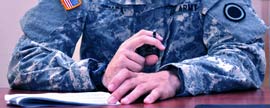After more than 10 years, we are beginning to drawn down major military operations that have tested our country. We will continue to the fight in Afghanistan until at least 2014 and most likely have a significant role in Iraq for years to come. Regardless, our military is reliving another drawdown cycle.
What is the drawdown cycle?

This cycle usually occurs after major military operations or when the government believes reductions in force are necessary based on a change in OPTEMPO. A classic example of a drawdown cycle is the peace dividend at the end of the cold war. The peace dividend was a political slogan made famous by George H.W. Bush that explained the economic benefits through cutting the defense budget.
When the nation needs to find a way to reduce expenditures, the military is typically one of the areas that pays the price in the battle to curb spending. It is expensive to maintain a fully capable, trained, and deployable force. Balancing national defense is more of an art than a science.
What gets cut?
The cycle usually consists of 3 main areas for reductions: research and development, troop strength, and training. Under our current economic situation we have already begun to cut research and development and troop reductions are starting this year (2011). In 2012, I predict we will begin to see deeper cuts in troop strength followed by a decrease in training dollars. There will be stiff competition for training dollars among Army units.
Research and Development
Research and development is expensive and we usually begin fighting a war with technology that was developed during a previous conflict or in an era when R&D dollars were more abundant. This means we typically go to war with less of a technological advantage than we actually have available. During a short term conflict the implications of this are minor but during a protracted conflict the absence of improved technology can cost lives.
Troop Strength
Reduction of force usually follows a cut in R&D. While these reductions tend to remove lower quality service members by raising standards in areas like physical fitness, weight control, and conduct, they also tend to cause a decrease in promotions and this can have an adverse impact on the quality of the force as good Soldiers leave the service in search of more pay and better opportunities.

In 2012, expect deeper cuts in troop strength followed by a decrease in training dollars.
I personally witnessed numerous officers exit the service in the early 1980’s because they had been passed over for promotion to major once, and did not want to take the chance of being removed from service by being passed over twice. The standards for retention were high, the chances for promotion were small, and the result was an exodus of qualified leaders with experience. The enlisted force experienced a similar issue during the 1990’s when it was decided to execute early retirements and allow Soldiers to separate from service earlier than the expiration of their contract. The result was an enlisted force that lost much experience that could not easily be replaced.
Training
Finally we come to training dollars. In the late 1980s I was in a briefing where the commander of TRADOC stated that while there would be a decrease in training dollars there would be no decrease in the quality of training. He also stated: “there would be no more Task Force Smiths” referring to the poorly trained group of Soldiers thrown into the initial offensive action of the Korean war that resulted in serious casualties as a result of inadequate training. While I believe the Army was sincere in their desire to maintain a well-trained force I also believe that the nature of politics and military service is difficult to balance. As the politicians need more cuts, the service must reduce training to comply.
As a result, we slowly move closer to an inadequately trained force. Commanders can find cost-effective ways to improve training, but there can be no replacement for hands on training that puts the Soldiers under strenuous conditions and in similar conditions in which they will be required to perform their duties. Training that is not realistic and challenging may provide minor benefits, but it does not stimulate thought or create an environment that fosters initiative and critical thinking or proficiency.
What does the future hold?
A review of our recent history shows that this cycle will be a continuous one as our government is in a constant struggle to maintain a balance between defense spending and budgetary requirements. It appears that we will always be caught between the swings of the pendulum. On one end is an inadequately funded force with insufficient training, and on the other we have a highly trained force on a runaway budget. It appears the truth of the matter is that we will never be able to fix this cycle. We can only attempt to control the severity of shifts by understanding how previous decisions have impacted our nation’s ability to field a highly motivate and well trained force.
What do you think? Will the looming budget cuts decrease our military effectiveness? Will there be more Task Force Smiths?












